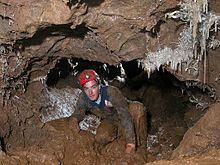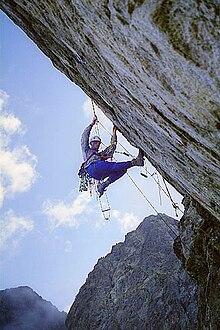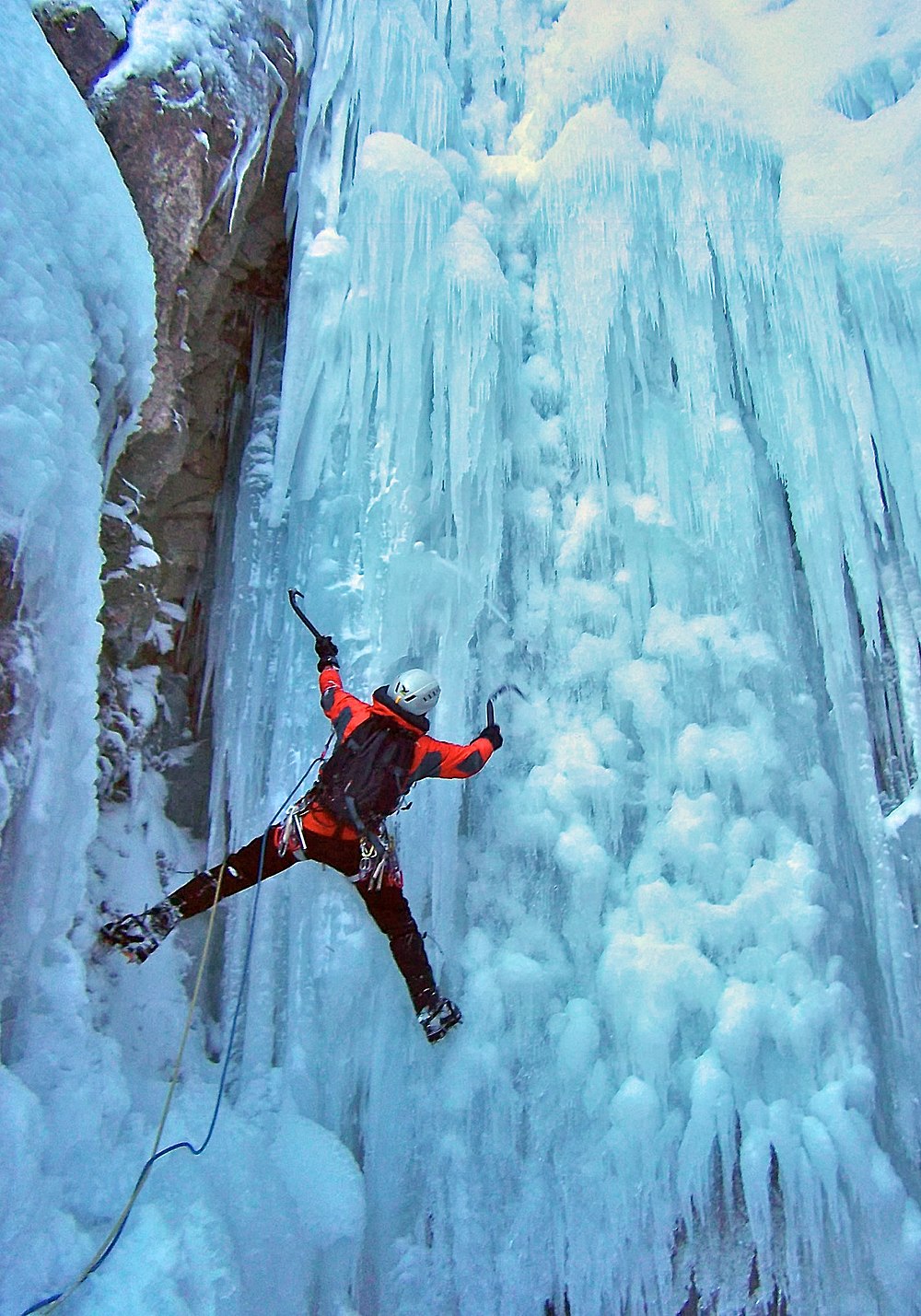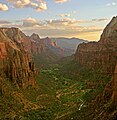Portal:Climbing
The Climbing Portal
Climbing is the activity of using one's hands, feet, or other parts of the body to ascend a steep topographical object that can range from the world's tallest mountains (e.g. the eight thousanders) to small boulders. Climbing is done for locomotion, sporting recreation, for competition, and is also done in trades that rely on ascension, such as rescue and military operations. Climbing is done indoors and outdoors, on natural surfaces (e.g. rock climbing and ice climbing), and on artificial surfaces (e.g. climbing walls and climbing gyms) (Full article...)
Random climbing article
Aid climbing is a form of rock climbing that uses mechanical devices and equipment, such as aiders (or ladders), for upward momentum. Aid climbing is different than free climbing (which can be performed as traditional or sport free climbing), which only uses mechanical equipment for protection, but not to assist in upward momentum. "Aid climbing" sometimes involves hammering in pitons and bolts, into which aiders are clipped, but there is also "clean aid climbing" which avoids hammering, using only removable placements.
While aid climbing traces its origins to the start of all climbing when ladders and pitons were common, its use in single-pitch climbing waned in the early 20th century with the rise of free climbing. At the same time, the Dolomites became the birthplace of modern "big wall aid climbing", where pioneers like Emilio Comici developed the early tools and techniques. Aid climbing's "golden age" was in the 1960s and 1970s on Yosemite's granite big walls led by pioneers such as Royal Robbins and Warren Harding, and later Jim Bridwell, and was also where Robbins' ethos of minimal-aid, and Yvon Chouinard's ethos of "clean aid climbing", became dominant. (Full article...)

Rock climbing is a sport in which participants climb up, across, or down natural rock formations or indoor climbing walls. The goal is to reach the summit of a formation or the endpoint of a usually pre-defined route without falling. Rock climbing is a physically and mentally demanding sport, one that often tests a climber's strength, endurance, agility and balance along with mental control. Knowledge of proper climbing techniques and the use of specialized climbing equipment is crucial for the safe completion of routes.
Because of the wide range and variety of rock formations around the world, rock climbing has been separated into several different styles and sub-disciplines, such as scrambling, bouldering, sport climbing, and trad (traditional) climbing.
Rock climbing competitions have the objectives of either completing the route in the least amount of attempts, the least amount of time, or attaining the farthest point on an increasingly difficult route. Indoor rock climbing is typically split into three disciplines: bouldering, lead climbing, and top roping. (Full article...)
Climbing sport disciplines
When lead climbing, the lead climber wears a harness tied to one end of a rope. The leader's partner provides the belay, paying out rope as needed, usually with the aid of a belay device, to catch the leader in the event of a fall. The lead climber ascends the route, periodically placing protection for safety in the event of a fall.
- International Competitions: Sport climbing at the 2020 Summer Olympics • IFSC Climbing World Championships • IFSC Climbing World Cup • Sport climbing at the World Games • IFSC Climbing European Championships • IFSC Climbing Asian Cup • Rock Master
- Organizations: International Federation of Sport Climbing (IFSC) • International Climbing and Mountaineering Federation (UIAA) • USA Climbing • German Alpine Club (DAV) • British Mountaineering Council (BMC)
- Disciplines: Lead • Bouldering • Speed • Ice • Deep Water Solo

Mountaineering, mountain climbing, or alpinism is a set of outdoor activities that involves ascending mountains. Mountaineering-related activities include traditional outdoor climbing, skiing, and traversing via ferratas that have become sports in their own right. Indoor climbing, sport climbing, and bouldering are also considered variants of mountaineering by some, but are part of a wide group of mountain sports.
Unlike most sports, mountaineering lacks widely applied formal rules, regulations, and governance; mountaineers adhere to a large variety of techniques and philosophies (including grading and guidebooks) when climbing mountains. Numerous local alpine clubs support mountaineers by hosting resources and social activities. A federation of alpine clubs, the International Climbing and Mountaineering Federation (UIAA), is the International Olympic Committee-recognized world organization for mountaineering and climbing. The consequences of mountaineering on the natural environment can be seen in terms of individual components of the environment (land relief, soil, vegetation, fauna, and landscape) and the location/zone of mountaineering activity (hiking, trekking, or climbing zone). Mountaineering impacts communities on economic, political, social and cultural levels, often leading to changes in people's worldviews influenced by globalization, specifically foreign cultures and lifestyles. (Full article...)
Selected Mountaineering Topics
- Mountaineering: Alpine style • Expedition style • Alpine Clubs • Boots • Crampons • Ice axes • Mountain huts • Mountain rescue • Ropes • Rucksacks • Effects of high altitude on humans
- History: Golden age of alpinism • Silver age of alpinism • Timeline of climbing Mount Everest • Exploration of the High Alps
- Alpine clubs: Alpine Club (UK) • German Alpine Club (DAV) • Austrian Alpine Club • Swiss Alpine Club • Club Alpino Italiano (CAI) • American Alpine Club • Japanese Alpine Club
- Pioneers: Christian Almer • Melchior Anderegg • Hermann von Barth • Walter Bonatti • Meta Brevoort • William Martin Conway • Angelo Dibona • Hans Dülfer • Paul Grohmann • Adolphus Warburton Moore • Paul Preuss • Ludwig Purtscheller • Schlagintweit brothers • Leslie Stephen • Gottlieb Samuel Studer • Tenzig Norgay • Herbert Tichy • Lucy Walker • Edward Whymper • Georg Winkler • Matthias Zurbriggen
- High-altitude mountaineers: Chris Bonington • Hermann Buhl • Kurt Diemberger • Ralf Dujmovits • Günther Dyhrenfurth • Maurice Herzog • Sir Edmund Hillary • Sandy Irvine • Gerlinde Kaltenbrunner • George Mallory • Nives Meroi • Reinhold Messner • Simone Moro • Oh Eun-sun • Edurne Pasaban • Wanda Rutkiewicz • Lionel Terray • Um Hong-Gil • Stephen Venables • Ed Viesturs • Other mountaineers
- Publicists: Karl Blodig • W. A. B. Coolidge • David Breashears • Jon Krakauer • Gaston Rébuffat
- Hands: Chalk • Athletic taping
- Feet: Climbing shoe • Approach shoe • Mountaineering boot • Crampons • Ice cleat
- Rope: Dynamic rope • Static rope • Kernmantle rope
- Rope control: Belay device • Figure 8 • Self-locking device • Ascender • Sling
- Harness: Climbing harness
- Connectors: Carabiner • Quickdraw • Maillon
- Protection devices: Hex • Nut • Spring-loaded camming device • Tricam • Piton
- Permanent anchors: Anchor • Bolt
- Training: Campus board • Climbing hold • Climbing wall
- Ice: Ice tool • Ice axe • Ice screw
- Miscellaneous: Helmet • Bouldering mat • Webbing • Portaledge • Rock climbing hammer • Copperhead
Random Selected Climber
Janja Garnbret (born 12 March 1999) is a Slovenian professional rock climber who specializes in sport climbing and competition climbing, and who has won multiple competition lead climbing and competition bouldering events. In 2021, she became the first-ever female Olympic gold medalist in climbing and is widely regarded as one of the greatest competition climbers of all time. She is also the world's first-ever female climber to onsight an 8c (5.14b) graded sport climbing route.
Garnbret won her first international title at the 2014 World Youth B Championships in lead. In July 2015, after turning 16, she entered the senior category of the IFSC Climbing World Cup in lead climbing. In 2016, aged 17, Garnbret won the World Cup seasonal titles in lead and combined, World Championships in lead climbing, and World Youth A Championships in both lead climbing and bouldering. From 2016 to 2018, she was awarded the seasonal title in both lead climbing and combined disciplines. In both 2018 and 2019, she won the World Championships in bouldering and combined and also reclaimed the lead title in 2019. The same year, Garnbret became the first athlete to win all bouldering World Cup events in a season. (Full article...)
Notable Climbers
- Competition climbers: Jakob Schubert • Janja Garnbret • Tomoa Narasaki • Jain Kim • Sean McColl • Akiyo Noguchi • Adam Ondra • Mina Markovic • Sean McColl • Akiyo Noguchi • Jakob Schubert • David Lama • Angela Eiter • Sandrine Levet • Tomáš Mrázek • Liv Sansoz • Kilian Fischhuber • Alexandre Chabot • François Petit
- 9b (5.15b) climbers: Chris Sharma • Adam Ondra • Jakob Schubert • Alex Megos • Sachi Amma • Stefano Ghisolfi • Ethan Pringle • Angela Eiter • Steve McClure • Sébastien Bouin • Julia Chanourdie
Climbing area
Glossary of climbing terms relates to rock climbing (including aid climbing, lead climbing, bouldering, and competition climbing), mountaineering, and to ice climbing. (Full article...)
Tree climbing is a recreational or functional activity consisting of ascending and moving around in the crowns of trees.
A rope, helmet, and harness can be used to increase the safety of the climber. Other equipment can also be used, depending on the experience and skill of the tree climber. Some tree climbers take special hammocks called "Treeboats" and Portaledges with them into canopies where they can have a picnic or sleep.
Some tree climbers employ a mixture of techniques and gear derived from rock climbing and caving. These techniques are also used to climb trees for other purposes: tree care (arborists), animal rescue, research, and activism. (Full article...)

Canyoning (canyoneering in the United States, kloofing in South Africa) is a sport that combines several outdoor sports like rock climbing, hiking, swimming, and rappelling. A canyoneer travels down canyons using a variety of techniques that may include other outdoor activities such as walking, scrambling, climbing, jumping, abseiling (rappelling), and swimming.
Although non-technical descents such as hiking down a canyon (canyon hiking) are often referred to as canyoneering, the terms canyoning and canyoneering are more often associated with technical descents — those that require abseils (rappels) and ropework, technical climbing or down-climbing, technical jumps, and/or technical swims.
Canyoning is frequently done in remote and rugged settings and often requires navigational, route-finding, and other wilderness travel skills. (Full article...)

Caving, also known as spelunking (United States and Canada) and potholing (United Kingdom and Ireland), is the recreational pastime of exploring wild cave systems (as distinguished from show caves). In contrast, speleology is the scientific study of caves and the cave environment.
The challenges involved in caving vary according to the cave being visited; in addition to the total absence of light beyond the entrance, negotiating pitches, squeezes, and water hazards can be difficult. Cave diving is a distinct, and more hazardous, sub-speciality undertaken by a small minority of technically proficient cavers. In an area of overlap between recreational pursuit and scientific study, the most devoted and serious-minded cavers become accomplished at the surveying and mapping of caves and the formal publication of their efforts. These are usually published freely and publicly, especially in the UK and other European countries, although in the US, these are generally private.
Sometimes categorized as an "extreme sport", it is not commonly considered as such by longtime enthusiasts, who may dislike the term for its connotation of disregard for safety. (Full article...)
Categories
Related Portals
Associated Wikimedia
The following Wikimedia Foundation sister projects provide more on this subject:
-
Commons
Free media repository -
Wikibooks
Free textbooks and manuals -
Wikidata
Free knowledge base -
Wikinews
Free-content news -
Wikiquote
Collection of quotations -
Wikisource
Free-content library -
Wikiversity
Free learning tools -
Wiktionary
Dictionary and thesaurus




































































































